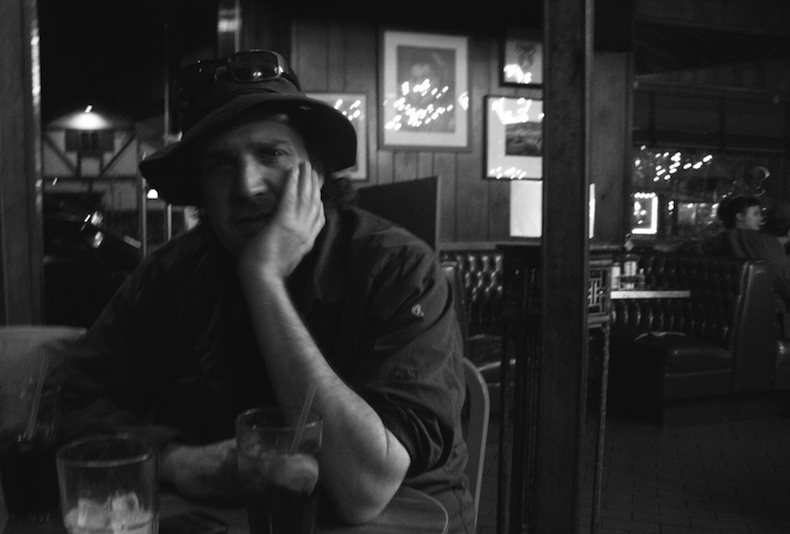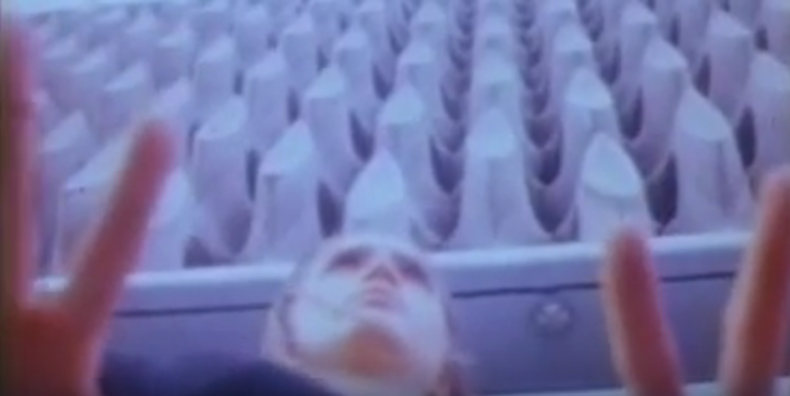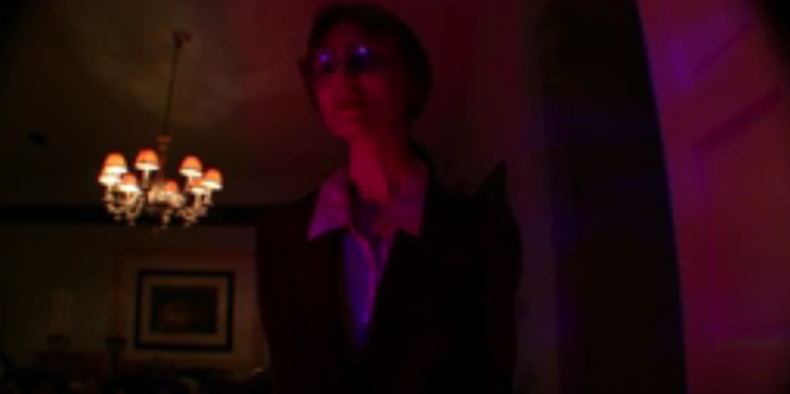In A Deadzone: On Damon Packard
23.05.16

Photo Credit: Rebekah Weikel
Cult filmmaker Damon Packard lives off Kickstarter. The fundraising he does on the site finances his films and pays the rent. He also sells Blu-ray discs of obscure films and does the occasional low-paid editing job to survive. Budget limitations inform Packard’s aesthetic: single characters are played by multiple actors, scenes inexplicably switch locations and bizarre plot points are created to explain away inconsistencies. His films slip between the fantasy and reality of Hollywood, often filtered through a pastiche of iconic 70s and 80s cinema.
I met Packard online in 2009, when we corresponded about screening his films in Australia. When I moved to Los Angeles from Melbourne in 2015, he was the only person I knew (apart from my wife). I suggested we meet up for coffee. He agreed. We met two more times, coincidentally at some of LA’s most-frequented diners, where we discussed his films, local history, and the decline of late-night culture in LA.
Coral Café, Burbank
Packard is nocturnal. When I attempt to meet him on an afternoon at 12:30pm, he retorts that 12:30am would be better. Eventually, he concedes. He tells me he can probably be awake by noon, so we confirm lunch. He suggests the Coral Café in Burbank.
This is the first time I’ve met Packard in person. Having recently moved to LA from Melbourne, I don’t have a car and am still in the public transport mindset—thinking I can get around LA on the Metro and on foot. After an hour and a half on two buses and the Red Line, I arrive at North Hollywood Station. It takes me another 45 minutes to walk the two miles along Burbank Boulevard to the Coral Café. Packard is already seated when I arrive in his signature fishing hat, jeans, and a t-shirt. True to its name, the Coral Café has a calm, pastel vibe. I introduce myself and sit down. He doesn’t remember me specifically—he has hundreds of friends on Facebook and people contact him all the time to organize screenings of his films.
Packard wants to hear about the screenings in Australia. He seems interested in the audience responses. A friend and I screened Packard’s Skatebang (2007) at a gallery in Melbourne along with some other video works. (Packard’s work could be considered a distant cousin to Ryan Trecartin’s, whose work we also planned to screen, until his gallerist revoked permission.) Skatebang features a series of teenage skateboarders thrown from their boards after being shot by hidden snipers, while black helicopters circle and Madonna’s Papa Don’t Preach plays in the background. It humorously exaggerates the media’s paranoid fixation on terrorism during the Bush era. The audience was visibly uncomfortable, occasionally breaking out into nervous laughter. The second screening was at the Electrofringe Festival in Newcastle, this time in a theatre, the audience visibly more relaxed and receptive. People were more relaxed and openly enjoyed themselves. Perhaps there is less pressure in a darkened theatre than in an austere white cube.
We both order ice tea. Packard orders the Caesar salad and I ask for a cheese quesadilla. He talks about his current project Fatal Pulse AKA Yuppie Fear Thriller. The film’s plot involves Janet Jackson’s manager, an illuminati conspiracy to stop time in 1991, and a pop locker murder plot. Packard managed to shoot scenes at the Less Than Zero mansion in Bel Air, Lautner’s Sheats-Goldstein Residence and a house in the Hollywood Hills. Due to budget limitations, the rest of the shoot will take place outdoors, though—in true Packard fashion—he hasn’t worked out all the details of the plot yet. “To be honest,” he confesses, “I don’t want to finish the film as I’ll have to stop the crowdfunder campaigns”—he’s worried about covering the rent. “But, the film was sold months ago and I have to send it to Fandor.”
After lunch, Packard offers to drive me back to Echo Park. He clears a bunch of junk off the passenger seat and we head off slowly—his transmission is busted so he can’t go more than 40 miles an hour. We take surface streets to avoid the 5 Freeway. The Freeway would get us to Echo Park in about 15 minutes, but our roundabout journey takes close to an hour. “I used to know LA like the back of my hand,” Packard confesses, “Now my memory’s gone. I think it’s the smartphone, it’s screwed with everyone’s memory.”
When he drops me off on Sunset, I tell him I’m currently looking for work, but then I realize that he is too. We say goodbye and I offer to help out on a film shoot if he needs it.

Brite Spot, Echo Park
It’s close to 10pm on a Monday night at Brite Spot in Echo Park. Packard and I have been immersed in our conversation when we realize the place is empty. All the young kids that were sitting at the tables around us have cleared out. We’re the only ones left. Packard can barely conceal his disdain. “This place used to be open until 3am and then they started closing early. LA is more and more of a ‘roll-up-the-sidewalks-early’ town. You may as well live in some small town in the Midwest.”
The waitress overhears; she’s worked here for years. When the bars closed at 2am the late crowd would come in, “We used to get hit until like 4am,” she says. “Things have really changed in the neighborhood.”
“What time do you guys close?” Packard asks. “We’re already closed, we closed at 9pm.” Packard is outraged. “That’s early, that’s really early for a diner. And this area is full of young people. These places all used to be open 24 hours in the 70s and 80s.”
LA’s ‘heyday’ for Packard, was the mid-80s when he was working in cinemas in Westwood. Now he considers it a “deadzone”—the only thing out there is UCLA and a few dwindling businesses. The cinemas, music stores, bookstores and newsstands are all gone.
When Packard worked in Westwood in the 80s, there were a number of single-house theatres in an enclosed area. Film premieres would take place, with well-known actors, directors, and cinematographers regularly coming through. In 2015, there are only two cinemas remaining, preserved as “national landmarks” by major studios that only use them for the occasional premiere.
“I started working [in Westwood] in about ‘84, I was still in high school. I wanted to be around movies and that was the easiest way to do it. I really wanted to work in a studio. I wanted to be like Spielberg. I wanted to sneak into Universal Studios and take over a little office and work on production. That’s what I wanted to do, but you know, it’s a little more difficult. So working at a movie theatre was the easiest way.” In the early 80s, Packard started making super 8 films, pre-empting Spielberg with a low-budget adaptation of Amazing Stories.
Reflections of Evil, Packard’s 2002 epic, is set in LA in the early 2000s. At one point the film shifts into a grainy, 70s flashback sequence where the protagonist’s sister sneaks off a Universal Studios tour into the backlot and witnesses a young Spielberg directing Something Evil. Initially, I thought the footage in the sequence was appropriated from a documentary (at least partially), but Packard assures me it’s all fiction. “I had a decent budget for that one,” he says. Though he does admit that he lifted Spielberg’s voice from the audio tracks of several “Making of…” documentaries including Jaws, Empire of the Sun and Jurassic Park. The sequence shows a young Spielberg trying to manage an older crew and failing, resulting in a slapstick disaster.
While Packard has produced several feature (or near feature) length films, he has also explored the movie trailer as art form, creating trailers for logistically or financially impossible films. Movie trailers often misrepresent the film they promote, emphasizing minor sub-plots or even presenting a different film entirely in order to appeal to a particular demographic. Packard’s Early 70s Horror Trailer (1999) and Dawn of an Evil Millennium (1988) tease with the possibility of a yet-to-be-made perfect film—something that will never come to pass.

Bob’s Big Boy, Burbank
We’re standing outside Bob’s Big Boy in Burbank. It’s around 11pm on a Thursday night. Packard takes a drag on his cigarette and checks his phone. A few teenagers wander inside while we stand next to the iconic, giant-sized Bob mascot. It’s one of the last diners in LA that’s open 24 hours, but, as Packard points out, “It’s almost empty. If you came here 35 years ago at midnight on a weekday it would be packed.”
Packard lives nearby, he’s only recently started coming here with his friend Duane Whitaker. “You might’ve seen him in Pulp Fiction,” he says, “He’s the guy in the pawn shop who pulls a gun on Bruce Willis. He’s a Texan guy, always playing bikers or something. Far more talented than Hollywood gives him credit for.” We walk inside and the waitress ushers us over to a booth near the window. “You know, a lot of out-of-work actors, writers, filmmakers come here, broke movie people living off their residual checks. I see a lot of friends of mine come here, editors, people like that.” Packard becomes enthused about the local history, “Burbank is like the Mecca for film.” He’s living just a few blocks from where the special effects were done for the original Star Trek series. We talk about how when people move to LA to “make it” in film they generally move to Hollywood, until they realize that it’s a terrible place to live. “It’s weird that I ended up living in this area, I usually just look for the cheapest place.”
While we’re talking, Packard points out a guy in a John Carpenter’s The Thing t-shirt. “That’s the third guy I’ve seen in a Thing t-shirt tonight. Where were they in 1982? Nobody cared about it then.” Packard recently finished a short titled John Carpenter’s Corpse about a group of special effects students who dig up Carpenter’s body (the film is set just after his death) and drag it to their graduation party. The film is soon to be released on a VHS compilation by Severin Films. “It’s about commercialized nostalgia,” he argues, “everything is commercialized nostalgia now, there’s nothing original being done. It’s all about reaching back into the past for inspiration.”
I ask him if he means film specifically, “I mean with everything. Film… music… fashion. Especially cinema, though. It seems like what I was saying in Foxfur, we’re living in a deadzone now, a sort of empty period where life did really end but we’re just schizm’ed off into some other dimension. We’re just looking at the past from this deadzone.”
Packard admits that all his films deal with this strange turn of events in some way. “It’s like the film I’m making now, Yuppie Fear Thriller, it’s set in the early 90s but time has frozen. I don’t see a lot of changes that have taken place since the late 80s. I mean we have cellphone technology and internet but all that stuff was around, it was just in its infancy—but the vibe is the same. Fear, punishment, rules, restrictions.” During the 70s and 80s he argues, there was an era of experimentation, “There were a lot of risks being taken. They didn’t know where the hell it was going, you could do anything.” But as soon as the markets were established, playing-it-safe was the lone strategy. “There was a big hardcore corporate takeover in the late 80s. Suddenly it was all about money and these yuppies and corporations were telling you to join the program or else get left behind. And nothing much has changed since then.”
The waitress takes our order, Packard orders a chicken sandwich and a Cherry Coke. I ask for the All American Burger and an iced tea. Packard checks Tinder. “All these girls,” he complains, “they’re all early people. There’s not one night owl. It would be nice just to meet one girl who was unemployed and sleeps all day.”
He shakes his head. “Less and less places are open late, less places are open 24 hours. The only people who are late-night people are unemployed, crazy, living on disability, somehow screwed up. There’s something wrong with you if you’re on a night schedule. Ninety-nine percent of the population are early morning people now.”
Why does he think this is the case? “Well I think people weren’t getting as tired and wiped out… in the 70s and 80s people were more active, there was more enthusiasm, drive, excitement, happiness, they were staying up later, celebrating and partying. We didn’t have a zillion distractions like we do now, things like social media that exhaust people. You know, the internet in a strange way exhausts people through doing nothing. You’re constantly working, emailing, texting, posting, looking at Facebook. I think that’s the problem. The sedentary lifestyle. If you’re on the computer all the time you’re going to be tired all the time.”
The waitress returns after we finish our sandwiches and we both order the apple pie with cream. “A traditional American kind of desert,” according to Packard.
After dinner he gives me a ride back to Echo Park. He’s got a new car, a Ford police cruiser, still sporting its black and white markings and complete with spotlights (“I use those sometimes on film shoots”). It’s nearly 1:30am and the freeway is deserted. After he drops me off, Packard is going to scout locations in Hollywood. “I need to find places that are out of the way, where I won’t be hassled by security guards or business owners.” We talk about new plot developments for Yuppie Fear Thriller. He’s shooting a scene with two detectives and we talk about the possibility of a Yakuza sub-plot. “I’m trying to work out what happens next. The whole movie is just constantly changing direction.”
I wave as he drops me off on the corner of my street, and watch as his aging cruiser dips onto Sunset Boulevard. The night is silent, until a police helicopter passes overhead. I close the door, content to be back in my own personal limbo.
—————–
Matthew O’Shannessy is a writer who recently relocated from Melbourne to California.